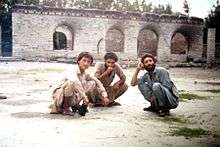Sectarian violence in Pakistan (1988)

In 1988 sectarian violence[1][2] erupted between rival sects in Gilgit-Baltistan, Pakistan, over a minor controversy on the sighting of the moon during the holy month of Ramadan.[3] The controversy triggered riots between Shiites and Sunnis, causing casualties on both sides. Due to rumors of a Sunni massacre in Gilgit, the tribal army from other areas of Pakistan attacked Gilgit.
Background
In May 1988, Pakistan's military dictator General Zia-ul-Haq, in an attempted massive sectarian attack,[4] sent a Lashkar (army) of militants, comprising natives of Afghanistan and Khyber Pakhtunkhwa, to attack the Shias living there. Sunnis, predominantly from Khyber Pakhtunkhwa’s tribal areas, assisted by local Sunnis from Chilas, Darel and Tangir, attacked several Shia villages on the outskirts of Gilgit on May 17, 1988.
Conflict
After reaching the outskirts of Gilgit without intervention from security agencies, Shias from surrounding villages were massacred and those who survived took refuge in Shia-dominated villages. Shiites from villages such as Sai, Bunji (which is also Pakistan Armed Forces Headquarter), Jaglote and Pari Bangla were forcibly expelled.
Next, Haramosh valley was attacked to reach Baltistan, but the attackers failed to achieve their goals and returned after suffering heavy casualties, despite having superior weapons and armed strength. They torched Shuto village on their way to Haramosh.
At the same time, another village named Jalalabad was attacked by militants. It was defended by local villagers and volunteers from Nagar, but after a day of heavy fighting, the attackers seized the village. This was the bloodiest clash during the conflict and heavy casualties were reported on both sides. Jalalabad and Batkor villages were torched, while the authorities did not interfere.
The next battle was reported from Sakwar (a village just outside Gilgit).Here the first 3 attacks were repelled due to having high position the villagers defend it well making 70+ casualties on other side but having lack of ammunition and manpower finally defence line was breached on 3rd day and dozens of houses were torched and looted .
Although contingents of the paramilitary Frontier Constabulary (FC) were eventually sent in, they too looked the other way while Sunni attackers wreaked havoc. By the time army units were sent in to quell the violence, many people were killed, several hundred injured and property worth millions of rupees destroyed.
Casualties
The exact number of casualties has been disputed. According to sources 150[5] to 400 people were killed while hundreds of others were injured. A report of the International Human Rights Observer’s (IHRO) Gilgit-Baltistan chapter estimates that around 3,000 people have been killed in Gilgit-Baltistan Province since 1988. On the loss of lives and its impact, IHRO states that about 900 women have been widowed and nearly 2,500 children orphaned. “The loss to property is inestimable.”
References
- ↑ "Pakistanis Barely Fazed by Shake-Up" By JOHN KIFNER, Special to the New York Times Published: June 1, 1988
- ↑ "Background Paper-Sectarian Conflict in Gilgit-Baltistan" by Mr. Muhammad Feyyaz, Published on: May 2011
- ↑ "Sectarianism in Gilgit-Baltistan by Seema Shekhawat Faultlines: Volume 20, January 18, 2011
- ↑ "Shia genocide in Gilgit Baltistan and the role of army-sponsored non-state actors" by Abdul Nishapuri
- ↑ "Gilgit-Baltistan: Murder most Foul" by Ambreen Agha